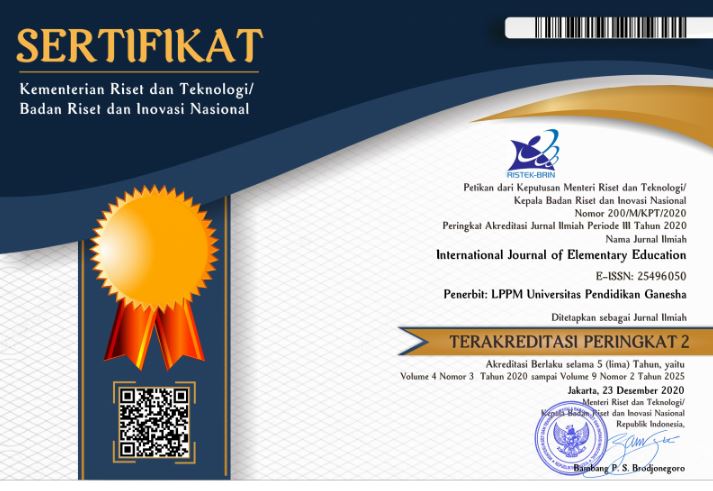Keefektifan Model Pembelajaran Sort Card pada Pembelajaran IPS terhadap Hasil Belajar Siswa Kelas III SD Negeri Karangroto 04 Kota Semarang
DOI:
https://doi.org/10.23887/ijee.v2i4.16273Abstract
The problem revealed in this study is how effective the Sort Card learning model is on social studies learning towards the learning outcomes of third grade students of Karangroto 04 State Elementary School in Semarang City. The purpose of this study was to determine the effectiveness of the Sort Card learning model on social studies learning on the learning outcomes of third grade students of Karangroto 04 Public Elementary School in Semarang City. This type of research is quantitative. The population in this study were class III students totaling 30 students and the design used for this study using One-Group Pretest-posttest Design. Data collection methods used are observation, tests, interviews, and documentation. The results of the study revealed the average value of pretest students 43,74 and the average posttest score of students was 88.86. From the calculation using the t-test, it is obtained t_count = 16.034 and ttable = 2.045 with db = 30-1 at the significant level α = 5%, so that t_count > t table is 16,034 > 2,045. So Ho is rejected and Ha is accepted. It can be concluded that the sort card model is effective against student learning outcomes. Based on the results of this study the suggestions that can be conveyed are expected teachers can use the sort card learning model in teaching and learning activities, especially social studies subjectsReferences
Arikunto, Suharsimi. 2013. Prosedur Penelitian. Jakarta: Rineka Cipta.
Billy Nurdiyanto. (2016). Penerapan Model Pembelajaran Card Sort Dalam Meningkatkan Motivasi Belajar Siswa Pada Mapel Tik Kelas Vii Di Smp Negeri 7 Pemalang. Jurnal Ilmu Komputer Untan. Vol 2 No 1.
Dimyati dan Mudjiono. 2006. Belajar dan Pembelajaran. Jakarta: Rineka Cipta.
Fakhrurrazi. (2016). Penerapan Metode Card Sort Dalam Peningkatan Motivasi Dan Kemampuan Belajar Siswa Bidang Studi Al-Qur’an Hadits Pada Siswa MTS Darul Huda Kota Langsa. JURNAL AL-IKHTIBAR (Jurnal Ilmu Pendidikan) Vol. 3 No. 2.
Hamalik O. 2005. Proses Belajar Mengajar. Jakarta: PT Bumi Aksara.
Hidayati Azkiya. 2017. Pengaruh Model Pembelajaran Aktif Tipe Card Sort dan Motivasi Belajar dalam Mata Kuliah Keterampilan Bersastra Ke SD-an Mahasiswa Prodi PGSD. Jurnal Bahastra Untan, Volume 37, Nomor 1, Edisi Maret (p) : 32 – 44.
Rahartika. (2015). Penerapan Model Pembelajaran Card Sort Dalam Meningkatkan Hasil Belajar Dan Keaktifan Siswa Pada Mapel Tik Kelas Vii Di Smp Negeri 7 Pemalang. Jurnal Ilmu Komputer Untan. Vol 2 No 1.
Rosida, Sukmawati, H.Zainuddin, (2013). Peningkatan Hasil Belajar dengan Strategi Card Sort Pelajaran IPA Kelas IV SDN 03 Segedong. Jurnal PGSD Untan. Vol 2 No 1.
Setiawan, Hendri. 2014. Penerapan Model Pembelajaran Kooperatif tipe NHT (Numbered Head Together) untuk meningkatkan Aktifitas dan Hasil Belajar teknik dasar passing bola basket pada siswa kelas VII SMPN 1 Sukasada. Jurnal PJOK Undiksha. Vol 2, No1.
Slameto. 2003. Belajar dan Faktor-Faktor yang Mempengaruhinya. Jakarta: PT. Rineka Cipta.
Sugiyono. 2016. Metode Penetitian Pendidikan. Bandung: Alfabeta.
Winda Fahrunnisa. (2016). Penerapan Model Pembelajaran Card Sort Untuk Meningkatkan Hasil Belajar IPS terpadu Siswa Kelas VII SMPN 7 Banda Aceh. Jurnal Ilmiah Mahasiswa Pendidikan Geografi Unsyah. Vol 1, No 1.
Zaini, Hisyam. (2008). Stategi Pembelajan Aktif. Yogyakarta: Pustaka Insan Madani.
Downloads
Published
How to Cite
Issue
Section
License
Authors who publish with the International Journal of Elementary Education agree to the following terms:
- Authors retain copyright and grant the journal the right of first publication with the work simultaneously licensed under a Creative Commons Attribution License (CC BY-SA 4.0) that allows others to share the work with an acknowledgment of the work's authorship and initial publication in this journal.
- Authors are able to enter into separate, additional contractual arrangements for the non-exclusive distribution of the journal's published version of the work (e.g., post it to an institutional repository or publish it in a book), with an acknowledgment of its initial publication in this journal.
- Authors are permitted and encouraged to post their work online (e.g., in institutional repositories or on their website) prior to and during the submission process, as it can lead to productive exchanges, as well as earlier and greater citation of published work. (See The Effect of Open Access)









